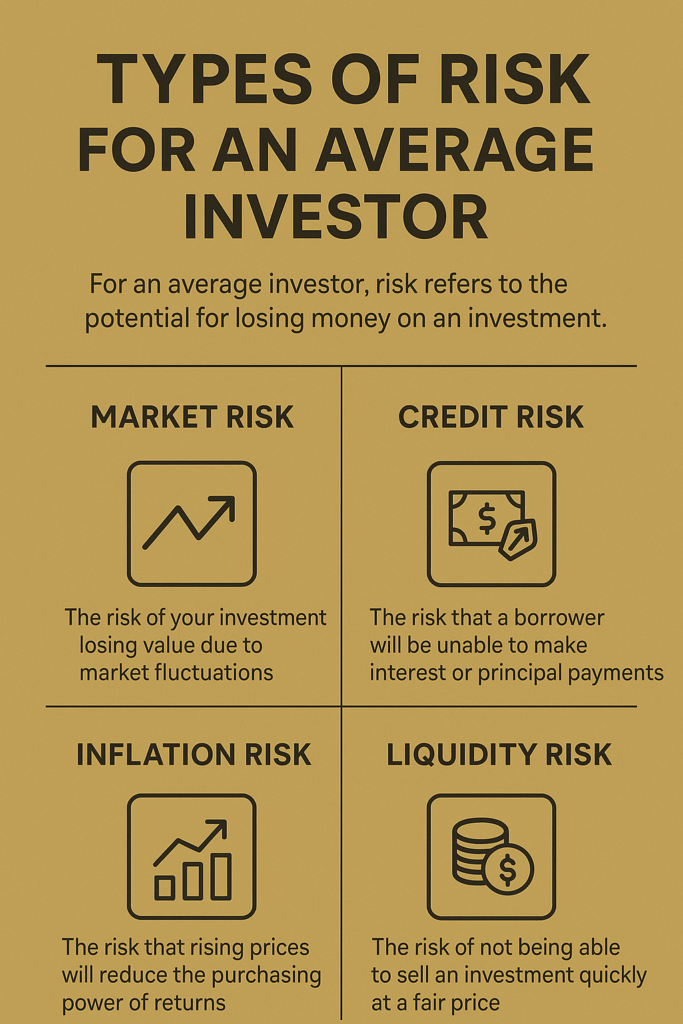When it comes to making your money work for you, one word inevitably takes centre stage: risk in investment. For the average investor, risk is the potential of losing some or all of your investment. But it’s not something to be feared—it’s something to understand, manage, and balance.
In this article, we’ll break down what risk really means, what factors you should consider, and how to weigh it up when making investment decisions.
What Is Investment Risk?
At its simplest, risk in investment is the uncertainty around the return you’ll receive. Every investment carries some level of risk—whether it’s the volatility of the stock market, the unpredictability of real estate prices, or the default risk of a bond issuer.
Risk isn’t inherently bad. In fact, higher potential returns typically come with higher risk. The key is to find a level of risk that matches your goals, time horizon, and comfort level.

Key Types of Investment Risk
- Market Risk
The risk that your investment’s value will fluctuate due to changes in the overall market. This is most relevant for stocks and mutual funds. - Credit Risk
Especially relevant for bonds, this is the risk that the issuer may not be able to make interest payments or repay the loan. - Inflation Risk
The risk that inflation will erode the purchasing power of your returns. - Liquidity Risk
The risk that you won’t be able to sell your investment quickly without losing value. - Concentration Risk
Putting too much money into one investment or sector can increase your exposure if that asset underperforms.
What Should the Average Investor Consider?
1. Your Time Horizon
How long can you leave your money invested? If you’re young and investing for retirement 30 years away, you may be able to tolerate more risk than someone nearing retirement.
2. Your Risk Tolerance
This is your emotional ability to handle the ups and downs of the market. Can you sleep at night if your portfolio drops 10% in a week? If not, you may want a more conservative strategy.
3. Your Financial Goals
What are you investing for—retirement, a home, your children’s education? Your goals help determine what kind of risk and return profile you should aim for.
4. Diversification
One of the most effective ways to manage risk is to spread your investments across different assets, industries, and geographies. This way, if one investment underperforms, others may balance it out.
5. Your Knowledge and Research
Understanding what you’re investing in reduces risk. Blindly following trends or tips can be dangerous. Take time to understand how an investment works and what could go wrong.
How to Weigh Up Risk
Start with your goals. Ask: How much do I need to earn, and by when?
Then consider:
- What is the worst-case scenario for this investment?
- How likely is that to happen?
- If it did happen, could I afford the loss or wait it out?
Use tools like risk profiling questionnaires, or work with a financial advisor to assess your situation. Even simple methods like the “Rule of 100” (100 minus your age = percentage of portfolio in stocks) can give you a baseline for risk allocation.
Final Thoughts: Risk Is Personal
There’s no one-size-fits-all answer when it comes to investment risk. What feels like a manageable risk for one person might feel reckless to another.
The goal isn’t to eliminate risk—it’s to understand it and make it work for you. With the right strategy, smart diversification, and an eye on your goals, risk becomes a tool—not a threat.
